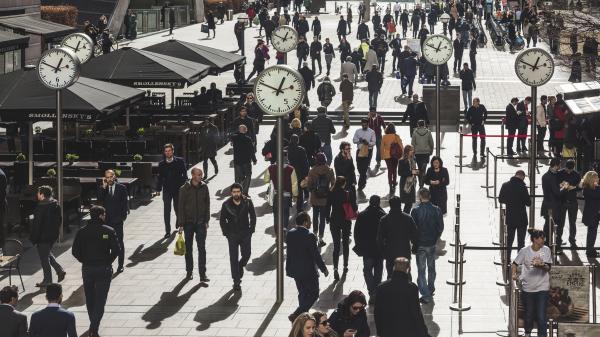What Is Daylight Saving Time?
About 40% of countries use Daylight Saving Time. Learn how it works, what makes it controversial, and why it’s not actually saving any daylight.

The art installation “Six Public Clocks” in Canary Wharf, London, U.K.
©iStockphoto.com/william87
Upcoming DST changes for your location
Daylight Saving Time (DST) is the practice of setting the clocks forward during part of the year to make better use of natural daylight. DST is usually one hour ahead of standard time and runs from spring to autumn—though there are exceptions.
“Spring Forward, Fall Back”
Every year, millions face the clock-changing ritual of DST—and based on our readers’ feedback, many still struggle to remember which way to turn the dial each spring and fall.
If you’re one of them, here’s a little saying to help you remember: Spring forward, fall back. So, you turn the clocks forward in the spring when DST begins and backward in the fall when DST ends.

Standard DST Routine and Notable Exceptions
About 40% of countries worldwide use DST—see the map.
DST start and end dates differ by country, although they generally follow a similar pattern: Clocks are usually advanced by one hour during the DST period, which begins in spring and ends in fall. However, since the seasons are opposite in the Northern and Southern Hemispheres, the DST routines are also reversed accordingly.
Northern Hemisphere
North America, Central America, Europe, Asia, northern Africa
Many countries in the Northern Hemisphere (north of the equator) use Daylight Saving Time. It is often referred to as Summer Time, but it lasts longer than just the summer months. DST usually starts in March-April and ends in September-November when the countries return to standard time, or winter time, as it is also known.
Southern Hemisphere
Australia, New Zealand, most of South America, southern Africa
In the Southern Hemisphere (south of the equator), the participating countries usually start the DST period in September-November and end the DST in March-April.
Exceptions
Of the countries that use DST, some don’t follow the usual routine. Here are some examples:
- On Lord Howe Island, Australia, clocks are turned ahead by only 30 minutes when DST takes effect, from LHST (UTC+10:30) to LHDT (UTC+11). (The island is also one of the few places in the world with an unusual UTC offset.)
- Some countries may pause DST during Ramadan to make it easier for people to observe the Ramadan fast during daylight hours. This means people have to change their clocks four times during the year.
- Throughout history, several variations have been used, like half adjustments (30 minutes) or double adjustments (2 hours). Adjustments of 20 and 40 minutes have also been used.
By the way, oddities like these make telling time tricky—and they are one of many reasons why running a website like timeanddate.com is tougher than it looks.

Just a few hundred people live on Lord Howe Island, Australia, but they follow one of the world’s most unique DST routines.
©iStockphoto.com/Elizabeth Allnutt
DST overview: tools, stats, and upcoming clock changes
Global database: All DST clock changes this year
Not Without Controversy
Although DST is widely used, it’s a rather unpopular measure, and many political initiatives have been launched to abolish it.
In the US, debates around DST arise almost every time clocks change, with growing public skepticism—only 33% of Americans see its purpose, according to a 2014 Rasmussen Report. Since 2015, over 200 DST-related bills have been introduced in nearly every state. Although some states have passed laws favoring permanent DST, federal law currently only allows opting out of DST—not staying on it year-round—so congressional approval is required.
In a social media post, President Donald Trump criticized DST as “inconvenient and very costly to our nation.”
In the EU, efforts to abolish DST gained momentum in 2019 when the European Parliament backed a proposal to end seasonal time changes. However, progress stalled in the European Council by 2021 due to logistical complications, and nothing major has happened since. In 2024, 67 Members of the European Parliament urged a renewed push, citing health concerns and questioning DST’s relevance in modern Europe.
Now, in 2025, the EU is taking steps to rescind the 2019 proposal to abolish DST clock changes. Read all about the latest suggestion.
Stay current on DST developments worldwide in our Time Zone News
So, Why Use DST at All?
Daylight Saving Time isn’t just unpopular—research suggests it may not even accomplish the objective it was originally designed to achieve: saving energy. But then again, other studies have found the opposite to be true, and some experts highlight the advantages of DST nobody talks about.
Similarly, some studies show that DST could reduce road accidents and injuries by supplying more daylight when more people use the roads. Other studies claim that DST changes might harm people’s health.
Whichever way you look at it, there is no simple answer to whether DST is good or bad. It all depends on numerous factors, which differ from country to country. Even the geographic location plays a role: Close to the equator, the day length doesn’t vary much during the year, so DST doesn’t make as much sense as at higher latitudes.
More Than 100 Years Old Practice
When Germany first set the clocks forward on April 30, 1916, it became the first country in the world to use DST on a national level. However, the town of Thunder Bay in Ontario, Canada, implemented DST as far back as 1908.
DST statistics: Past and present use
It is a common misconception that US inventor and politician Benjamin Franklin first proposed the concept of DST in 1784. However, his idea didn’t involve clock changes and was meant as a joke. DST, in its modern form, was first suggested in 1895.